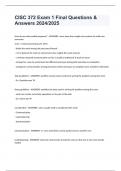-
1. Tentamen (uitwerkingen) - Cisc 120 final exam questions & answers 2024/2025
-
2. Tentamen (uitwerkingen) - Cisc final exam questions & answers 2024/2025
-
3. Tentamen (uitwerkingen) - Cisc 2820 final test questions & answers 2024/2025
-
4. Tentamen (uitwerkingen) - Cisc 1050 exam questions & answers 2024/2025
-
5. Tentamen (uitwerkingen) - Cisc 110 final exam questions & answers 2024/2025
-
6. Tentamen (uitwerkingen) - Cisc 3140 final exam questions & answers 2024/2025
-
7. Tentamen (uitwerkingen) - Cisc 120 review final exam questions & answers 2024/2025
-
8. Tentamen (uitwerkingen) - Cisc 115 final review exam questions & answers 2024/2025
-
9. Tentamen (uitwerkingen) - Cisc 3140 exam 1 questions & answers 2024/2025
-
10. Tentamen (uitwerkingen) - Cisc exam final questions & answers 2024/2025
-
11. Tentamen (uitwerkingen) - Cisc 310 final test questions & answers 2024/2025
-
12. Tentamen (uitwerkingen) - Cisc 360 final exam questions & answers 2024/2025
-
13. Tentamen (uitwerkingen) - Cisc 2820w exam questions & answers 2024/2025
-
14. Tentamen (uitwerkingen) - Cisc 124 final exam questions & answers 2024/2025
-
15. Tentamen (uitwerkingen) - Cisc 115 exam 1 questions & answers 2024/2025
-
16. Tentamen (uitwerkingen) - Cisc 200 exam questions & answers 2024/2025
-
17. Tentamen (uitwerkingen) - Cisc 121 exam questions & answers 2024/2025
-
18. Tentamen (uitwerkingen) - Cisc 3140 final exam 1 questions & answers 2024/2025
-
19. Tentamen (uitwerkingen) - Cisc 128 exam final review questions & answers 2024/2025
-
20. Tentamen (uitwerkingen) - Cisc 108 exam 1 questions & answers 2024/2025
-
21. Tentamen (uitwerkingen) - Cisc 310 final exam questions & answers 2024/2025
-
22. Tentamen (uitwerkingen) - Cisc 201 final test study guide questions & answers 2024/2025
-
23. Tentamen (uitwerkingen) - Cisc 106 final exam questions & answers 2024/2025
-
24. Tentamen (uitwerkingen) - Cisc exam 2 questions & answers 2024/2025
-
25. Tentamen (uitwerkingen) - Cisc 120 ch 7 final exam questions & answers 2024/2025
-
26. Tentamen (uitwerkingen) - Cisc 350 final exam questions & answers 2024/2025
-
27. Tentamen (uitwerkingen) - Cisc ch 3 exam questions & answers 2024/2025
-
28. Tentamen (uitwerkingen) - Cisc 115 prep final exam questions & answers 2024/2025
-
29. Tentamen (uitwerkingen) - Cisc 310 practice exam questions & answers 2024/2025
-
30. Tentamen (uitwerkingen) - Cisc 3140 exam 2 questions & answers 2024/2025
-
31. Tentamen (uitwerkingen) - Cisc 110 final study guide exam questions & answers 2024/2025
-
32. Tentamen (uitwerkingen) - Cisc 121 exam 1 questions & answers 2024/2025
-
33. Tentamen (uitwerkingen) - Cisc 3140 final review exam questions & answers 2024/2025
-
34. Tentamen (uitwerkingen) - Cisc 372 exam 1 final questions & answers 2024/2025
-
35. Tentamen (uitwerkingen) - Cisc 310 unit 2,3 exam 1 study guide questions & answers 2024/2025
-
36. Tentamen (uitwerkingen) - Cisc 3325 exam 1 questions & answers 2024/2025
-
37. Tentamen (uitwerkingen) - Cisc 181 test questions & answers 2024/2025
-
38. Tentamen (uitwerkingen) - Cisc 190 exam 1 questions & answers 2024/2025
-
39. Tentamen (uitwerkingen) - Cisc 310 exam 1 questions & answers 2024/2025
-
40. Tentamen (uitwerkingen) - Cisc 1003 exam 1 questions & answers 2024/2025
-
41. Tentamen (uitwerkingen) - Cisc 419 exam 3 questions & answers 2024/2025
-
42. Tentamen (uitwerkingen) - Cisc 181 exam 2 questions & answers 2024/2025
-
43. Tentamen (uitwerkingen) - Cisc 2820w exam 2 questions & answers 2024/2025
-
44. Tentamen (uitwerkingen) - Cisc 1003 exam 2 questions & answers 2024/2025
-
45. Tentamen (uitwerkingen) - Cisc 3140 final review exam 1 questions & answers 2024/2025
-
46. Tentamen (uitwerkingen) - Cisc 220 final exam questions & answers 2024/2025
-
47. Tentamen (uitwerkingen) - Risc cisc exam questions & answers 2024/2025
-
48. Tentamen (uitwerkingen) - Cisc vs risc exam questions & answers 2024/2025
-
49. Tentamen (uitwerkingen) - Risc cisc final test questions & answers 2024/2025
-
50. Tentamen (uitwerkingen) - Cisc test questions & answers 2024/2025
-
51. Tentamen (uitwerkingen) - Cisc 310 module 1 comprehensive final exam grade a+ 2024/2025
-
52. Tentamen (uitwerkingen) - Cisc 101 test questions grade a+ 2024/2025
-
Meer zien





